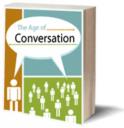 That Magical Reader Loyalty
That Magical Reader Loyalty
(NOTE: no spoilers here!) The Harry Potter series of books is a great example of reader/consumer loyalty. After all, they have stuck with Harry through 7 books, 199 chapters, and over 4100 pages. Many waited line in the US this past weekend, some dressed in costume, all excited to be one of the first to get hold of the last book in the series. Parties were held all over the country (thanks for pointing out this Harry Potter event, Chris!). On the beach here in San Diego today, I lost count of how many people were sitting in chairs poring through the book.
Each fan has their own way of dealing with the end of the series. Some, such as Doug Meacham of NextUp, stepped around the aftermath of the Harry Potter Midnight Party at their local bookstore to buy a copy and start the read (although Doug had a hard time finding it in some places!). Ann Handley of Marketing Profs decided to take matters into her own hands and read the end first in order to avoid hearing about it accidentally.
Does the hype about the end, the spoilers, and the movie bother these people? No. They are loyal fans, and they are dedicated to reading the final book no matter what.
How can you make your product or service impervious to outside interference? Building strong customer relationships is one of the first steps.
Marketing Bloggers and Media Unite!
A great event is taking place in the community. Todd Andrlik’s Power 150 ranking of top marketing blogs is partnering with Ad Age! Todd has worked tremendously hard to continually rank over 350+ marketing and PR blogs. In his post today announcing the inside scoop, Todd quotes Jonah Bloom, editor of Advertising Age, as follows:
“Of course we could have put something together based on our own opinions or bloggers’ traffic numbers, but Todd’s brilliant creation goes way beyond that and creates a ranking that combines traffic, influence and quality into a ranking of the best out there. We’re excited to be able to bring that to our readers. We also hope it’ll be a great thing for all bloggers listed.”
Congratulations go out to Todd for his perseverance; it paid off! Congrats also to the blogging community, as we are making an impact on the business world by writing quality content. Thank you also to Todd for including Customers Rock! on the list; it has been an honor!
In a related story, Kami Huyse of Communication Overtones points out that only 13% of the Power 150 are women. She shares the Top 20 PowerWomen of PR and Marketing (blogs) to help raise the awareness of top women bloggers. Thanks for the hat tip, Kami!
Meme-Mania: 8 Things About Me and Glass Half Full
Over the past few weeks, I have been tagged for the 8 Things meme by Janet Green, Steve Woodruff, Valeria Maltoni, Doug Meacham, and Nick Rice. This meme asks the person tagged to share 8 things about themselves, as a way of getting to know the blogger better. The tagged person should then tag 8 others to share some link love and to share great blogs. In addition to the “5 Things About Me” from awhile back, here are 8 more things …
1. I am a fan of science fiction movies and books (especially the “classic” movies from the 60s-80s such as Planet of the Apes, Logan’s Run, E.T., Close Encounters, Star Wars, and one of my faves Total Recall). Sharing them with my boys is a lot of fun, even if they do laugh at some of the “older” special effects!
2. I was once in the circus as a child. Ringling Brothers Circus came to town, and my sister and I were chosen to be in the parade. It was very memorable!
3. One of my favorite places on Earth is Maui. We vacation there on a regular basis and stay with some lovely friends. Aloha!
4. My husband and I love to travel. We have been all over Europe and the UK, and we hope to go again soon! I once travelled all the way around the world on a business trip for Hewlett-Packard when I was working there as a marketing manager – and I was 5 months pregnant!
5. I enjoy drinking red wine, especially if it is paired with Scharfenberger Chocolate. Yum!
6. I just learned how to knit this year. I think I will keep my day job, though, as I am not very good at it!
7. My favorite actor is Gene Kelley. What an amazing actor/singer/dancer! When my kids saw his “I Got Rhythm” tap dance in the movie American in Paris recently, one of them said, “Those aren’t really his feet moving! The computer did that.”
8. I am a huge fan of Disneyland and Disneyworld. One of the first things I did when we moved to San Diego was buy Disneyland season passes for all of us. Tell me if any of you come out this way, and I will meet you at Mickey’s house! 🙂
I was also tagged for the Glass Half Full meme a little while back, this time by Meikah Delid and Ryan Karpeles. Sorry to take so long to respond, guys! This meme asked the blogger to answer a few questions. Here they are:
1. How full is your glass?
2. What kind of glass is it?
3. What’s in the glass?
4. Reasons for #1, #2, and #3
And here are my answers:
1. My cup runneth over.
2. A red wine glass.
3. Ravenswood Zinfandel.
4. Reasons: My cup runneth over because I have been truly blessed in my life, much beyond what I could have imagined or deserved. The glass is a wine glass because I enjoy drinking red wine with family and friends while noshing on dark chocolate. The contents are Ravenswood Zinfandel because Ravenswood is a Customers Rock! company, plus it reminds me of my connections to the blogging community (fellow Ravenswood fan Steve Woodruff has been great at creating community with BrandingWire).
I now tag the following people (and apologies if you have already been tagged!): Daksh at TheMarketingBlog, Kevin Hillstrom of MineThatData, Katie Konrath of GetFreshMinds, Tim Jackson of MasiGuy, Daniel Sitter of Idea Sellers, Kevin Dugan of Strategic Public Relations, Dale Wolf of The Perfect Customer Experience, and Christy Brewer of The Diff.
You can choose which meme you want to respond to! Have fun.
(Photo by nruboc)
 I have blogged before about the little things that make a difference. I have had several online experiences the last year with a small California-based company that makes my online buying experience great with little things.
I have blogged before about the little things that make a difference. I have had several online experiences the last year with a small California-based company that makes my online buying experience great with little things.















